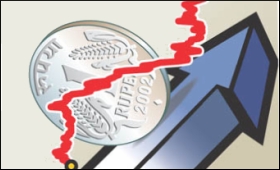|
|
|

|
FinMin cautions of inflationary risks on rising commodity prices, input costs
|
|

|
|
| Top Stories |
 |
|
|
|
SME Times News Bureau | 09 Jul, 2021
The Finance Ministry has cautioned of inflationary risks to the economy
due to global demand-driven recovery in commodity prices and high input
cost.
The Monthly Economic Review for June 2021 released by the
Department of Economic Affairs (DEA) noted that inflationary pressures
took an upturn in May 2021 with headline inflation (CPI-C) and WPI
inflation touching a high of 6.3 percent and 12.94 per cent,
respectively.
Supply side disruptions in states and unfavourable
base effects drove the broad-based momentum in retail inflation across
food, fuel and core categories. On the other hand, electricity and
manufactured products inflation led the uptick in wholesale inflation.
Healthy
monsoon coverage, gradually rising Kharif sowing and unlocking of
states is expected to ease food, and thereby headline, inflation, it
said.
"However, risks due to global demand-led recovery in commodity prices and input cost pressures remain," it said.
As
the Indian economy struggles to shed the impact of the second wave of
Covid-19, the report suggested that maintaining a fast past of
vaccination and plugging the lags in the healthcare infrastructure in
the country would be the most sustainable stimulus for the durable
recovery of the Indian economy.
Resilient tax collections of the
Central government in the first two months of FY 2020-21 and sustained
momentum in capital expenditure, particularly in the road and rail
sector, augurs well for continued economic recovery driven by capital
expenditures, it said.
The recently announced economic relief
package is expected to further oil the wheels of the capex cycle via
implementation of the PLI scheme and streamlining of processes for PPP
Projects and Asset Monetisation, the review said.
Consumption
sentiment is expected to pick up with further enhancement of employment
support under the Aatma Nirbhar Bharat Rozgar Yojana (ANBRY), targeted
support to the urban poor through the credit guarantee scheme for
on-lending by micro-finance institutions, and wider Bharat-Net
digitisation coverage.
Free food-grain and enhanced fertiliser
subsidies under the package along with continued MGNREGA implementation,
on the other hand, would serve as a cushion for rural demand in the
coming quarters, the review said.
|
|
|
| |
|
|
|
|
|
|
|
|
|
|
|
|
|
|
| |
| Customs Exchange Rates |
| Currency |
Import |
Export |
US Dollar
|
66.20
|
64.50 |
UK Pound
|
87.50
|
84.65 |
Euro
|
78.25
|
75.65 |
| Japanese
Yen |
58.85 |
56.85 |
| As on 13 Aug, 2022 |
|
|
| Daily Poll |
 |
 |
| PM Modi's recent US visit to redefine India-US bilateral relations |
|
|
|
|
|
| Commented Stories |
 |
|
|
|
|
|
| |
|